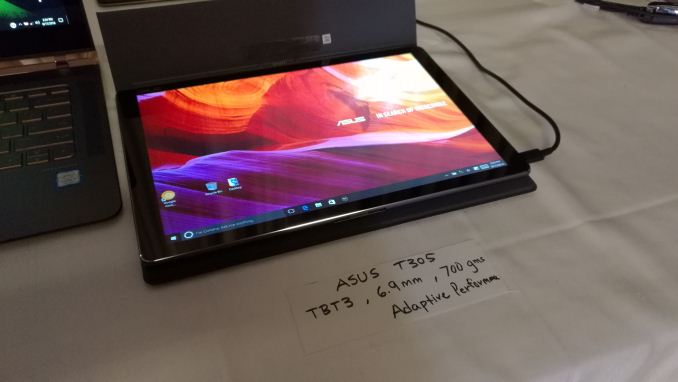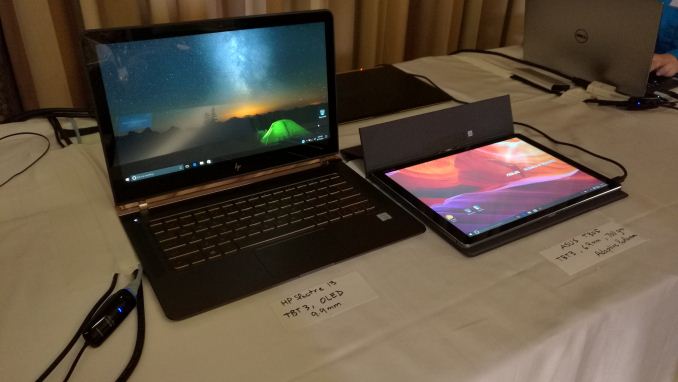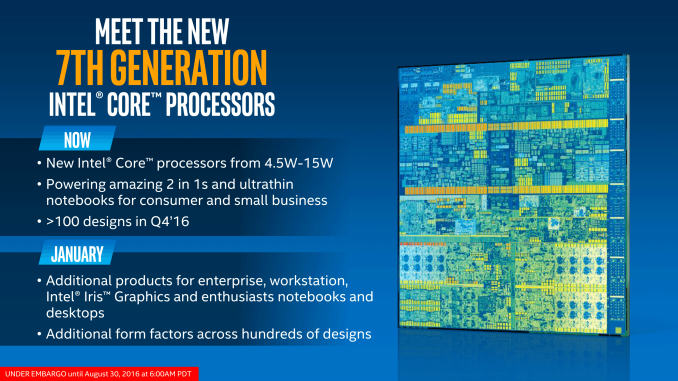Intel Announces 7th Gen Kaby Lake: 14nm PLUS, Six Notebook SKUs, Desktop coming in January
by Ganesh T S & Ian Cutress on August 30, 2016 9:00 AM EST- Posted in
- CPUs
- Intel
- 14nm
- Kaby Lake
- Gen 9
- Speed Shift
- Turbo Boost
Upcoming Hardware
Calling back to Computex, ASUS first announced a new Transformer device based on ‘Intel’s Next Generation’ processor. We knew it was Kaby Lake, but given the launch cycle for KBL it was understandable that the device was still a couple of months out and a work in process. At that point of the game the hardware specifications are typically squared away, and final touches are being made to the design ID as well as strong work on the software platform and ramping up the manufacturing aspect. We expect ASUS to launch their new Transformer products in due course.
At Intel’s pre-briefing for Kaby Lake, several systems were on display from HP all using the new processors. Specifications were not discussed, however devices with 4K panels and a variety of sizes were shown, including what looked like an upgraded Spectre, as well as a notebook with an OLED display.
This week is the annual IFA trade show in Berlin, which focuses on complete consumer electronics rather than components, as well as home appliances, IoT, and other things in-between. We have presentations and press events for a wide variety of companies including Acer, Samsung, Lenovo, Huawei, ZTE, and Sony, all of whom could be announcing something around Kaby Lake. (Qualcomm and AMD are also presenting at the show, but something tells me it isn’t to do with KBL.)
Explaining Why There’s No Desktop Parts Today
For the majority of enthusiasts, PC builders and gamers, questions about the time frame of the desktop processor launches, the benefits they bring and the pricing are swirling around the zeitgeist. Intel has confirmed with today’s launch that a wider array of Kaby Lake parts will be launched in January, including Iris graphics enabled processors, desktop parts, enterprise parts and workstation SKUs (vPro and Xeons, one would assume).
Despite the fact that this is still 14nm, one could assume that 14nm+ was focused on the small die parts first to improve yield before the larger desktop parts were produced, depending on how difficult the shift from 14 to 14+ actually was. There’s also the consideration about Intel’s product lines: Skylake on the desktop was only launched 12 months ago, and the next generation 10nm Intel product is - admittedly looking into a very foggy crystal ball - over a year away and will be mobile focused again as smaller dies are easier to make. Intel has to sufficiently space out its product stacks to ensure maximum profit, appease shareholders, but also give their customers a regular, expected update cycle. There’s a reason we don’t see the best product Intel could ever make on day one at unlimited expense.
Given that Intel has said that KBL is a similar IPC to SKL, it might be a bit worrying if desktop performance of the new parts is identical to the old ones, merely bumped up in frequency. Typically a small frequency bump mirrors a basic overclock; importantly however, if the pitch has been widened to allow a higher frequency, this could have a beneficial knock on effect for overclocking. Despite marketing efforts, Intel still limits overclocking to the two high-end SKUs, so how well Kaby Lake overclocks could prove important with desktop enthusiasts. If it overclocks better than Skylake, then we might be looking at the Skylake equivalent of the Haswell Refresh/Devil's Canyon. However if KBL offers the same OC frequency as SKL, and the same performance due to a similar IPC, then enthusiasts might not be interested. Ultimately Intel is going to market the new chips as a 3-5 year upgrade option for users still on Nehalem, Westmere and Sandy Bridge. This is ultimately where Intel believes most of the upgrade sales are coming from, rather than users jumping from Skylake.
The other factor is the motherboard side of the equation. We know that Kaby Lake on the desktop is to be accompanied by a new chipset launch as well, the 200-series, and typically if we were expecting a September launch then we would have seen motherboard examples at Computex. At the show, only MSI had an ‘unlabeled 200-series’ motherboard on show, which looked pretty identical to a Z170 product already on sale barring the design ID. We don’t yet know the benefits of the 200-series chipset over the 100-series line, and a release date in January would mean that motherboard manufacturers should now be in the final design steps for their major SKUs.
Saying ‘January’ as a launch date is quite vague. But, January has the annual CES event in Las Vegas during the first week after New Year, which is a common time to launch new CPUs after the holiday season finishes and people are ‘rested’.
Finally, it’s also worth noting that AMD is planning to enable widespread availability for their new Zen set of CPUs in Q1. So a January launch for desktop Kaby Lake could provide a more contested one for Intel. (If they also launch at CES, I need to start bulk ordering caffeine drips today. Goodbye sleep, it was nice knowing you. I may not be seen the rest of January.)
After all that, I’m pretty sure it’s pronounced Kay-bee Lake.














129 Comments
View All Comments
lilmoe - Saturday, September 3, 2016 - link
I couldn't give a rat's bottom how cheap Intel's chips become. If AMD gets similar performance at reasonable prices, then good-bye Intel for me.BillBear - Tuesday, August 30, 2016 - link
Given the new 14nm+ process, is it safe to speculate that the original problem with 14nm that delayed the hell out of Broadwell and outright killed some of the desktop versions of Broadwell was a power leakage problem?saratoga4 - Tuesday, August 30, 2016 - link
I don't think leakage was a huge problem. Yields appear to have been though. Intel has some slides explaining that they ramped slower than expected.Jumangi - Tuesday, August 30, 2016 - link
So possibly no real IPC gains in the desktop version? No point in waiting if your looking to upgrade then.wumpus - Tuesday, August 30, 2016 - link
Not for this. I keep looking at that die photo and wondering how hard it would be to replace some of that silly graphics bit with 2-4 cores. Maybe they will do it once zen ships. Maybe it would generate too much heat and won't work (I suspect the big multicore jobs have more cache/core area than these chips have (GPU+cache)/core). Maybe Intel will someday include a pony.Molor - Tuesday, August 30, 2016 - link
They kind of do that. They call it the extreme version and charge more for it. Graphics nodes tend to be more forgiving of flaws due to redundancy. AMD and NVidia usually disable a broken SM or two per chip for yields. It would be interesting to know if Intel does the same.shabby - Tuesday, August 30, 2016 - link
Pretty much, the 12% benchmark increase came from a 13% clock bump, same wattage though apparently.someonesomewherelse - Thursday, September 1, 2016 - link
Are you talking about single thread IPC or total chip? I think that single thread IPC improvements are going to (or already have) become too expensive for most applications and without programmer/compiler help. Things that vectorize well are probably the last area where large improvements are realistic. But this will either require great programmers that can actually utilize current (AVX2) and future SIMD instructions in their code + higher development costs or dropping support for older cpus (neither sounds good). Per chip IPC is probably easier but you still need good programmers/compilers or the use of multiple expensive applications at the same time (why not play a game while encoding 3 videos.... with enough cores/threads/cache/memory bw/io b this would work) .Clocks could still be increased if you are willing to accept high power consumption and expensive cooling.
However unless Zen is an extreme success Intel has no reason to do this since slow and expensive increases are more profitable and they have no reason to do this.
akmittal - Tuesday, August 30, 2016 - link
Any chance to see these in this year's macbook lineup.lilmoe - Tuesday, August 30, 2016 - link
As much as I dislike Apple's ways, sometimes they do things for a reason.1) Apple seems very hesitant to bother with Skylake because the various problems/bugs associated with the new architecture. It seams that Haswell/Broadwell is doing the job good enough for them and the "new features" aren't worth it in their general assessment. Macbooks are more media consumption/creation-centric and they're probably waiting on the new fix-function features.
2) Cost and profitability. If the above is true, it makes sense to stay with Haswell/Bradwell to maximize profit. Just like how they're using 3 gen old AMD graphics.
3) Lower than expected demand? Not so sure, but possible.
4) And I'm being hopeful here: *Zen* (and future HBM APUs). Keller has a history working "with" Apple, and they actually like his designs which play well with their OS(s). I'm being hopeful because Apple's marketing prowess and branding may be the beacon AMD (and the competitive market) needs to unleash the new platform and drive Intel to a corner forcing them to lower prices.